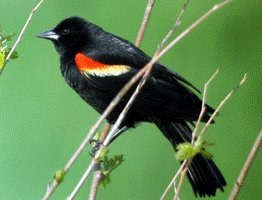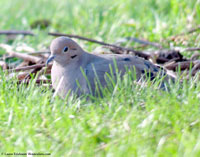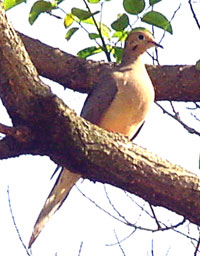|
The Mourning Dove's gentle, soft-spoken ways make it one of the most popular of backyard birds, yet ironically it is also the most heavily hunted of all game birds in the United States. In states where it has multiple nestings throughout most of the year, the Mourning Dove population can easily survive this hunt. In the forested eastern states in the northern extremes of its range, from Minnesota through to New England, it was wisely kept off gamebird lists for almost a hundred years. But in recent years there has been a huge and concerted effort by sportsmens' groups, in the face of tremendous public opposition, to add the Mourning Dove to the gamebird lists of Ohio, Michigan, Wisconsin, and Minnesota, despite a significant regional drop in the species' population (probably due to changes in agriculture as more and more small farms disappear and agri-corporations take over). In every case I'm aware of, hunters debating the issue have touted their conservation record, yet not in a single case did they propose limiting hunters in this new hunt to non-toxic shot, even though there are plenty of studies now verifying that Mourning Doves ingest shot as grit. I also find it frustrating that the main reason another game bird is "needed" is that hunters have so squandered some of the birds that are currently game species, such as Sharp-tailed Grouse and American Woodcock. These species' populations almost certainly have declined because of habitat losses, but without a doubt hunting pressure has exacerbated the losses, and the cries of hunters about all their contributions to "habitat acquisition and improvement" ring hollow when you look at species such as these. I saw my first prairie chickens in Michigan in 1976. Now this species has been extirpated from the entire state as hunters gave up on them and worked hard to increase the number of competing, exotic pheasants in Michigan. When hunters start being true conservationists again, recognizing the devastation their management of White-tailed Deer and Canada Geese has wreaked and joining forces to rectify those population imbalances; when they stop raining toxic lead shot on the countryside; and when they start working to restore numbers of Sage Grouse, Sharp-tailed Grouse, American Woodcock, and other declining traditional game species through habitat improvement and a hunting moratorium where appropriate, I'll reconsider. But for now, the hunting community seems more akin to Dick Cheney, who killed 80 pheasants and an undisclosed number of Mallards in a single day in an extraordinary public exhibition of chutzpah and bloodlust, than Aldo Leopold and Theodore Roosevelt, both of whom were exemplary sportsmen AND conservationists. Mourning Dove Photo Gallery (I need to add a LOT more photos!) Learn more about Mourning Doves
How you can help Mourning Doves:
How you can see and attract Mourning Doves: With their relatively tiny head and thin neck relative to their plump body, and their distinctive tail, which tapers to a point, Mourning Doves are easy to spot even as you drive along a highway when they're perched on wires. They're also easy to notice when you hear their distinctive calls, or when their wings beat noisily as they fly past.
|



